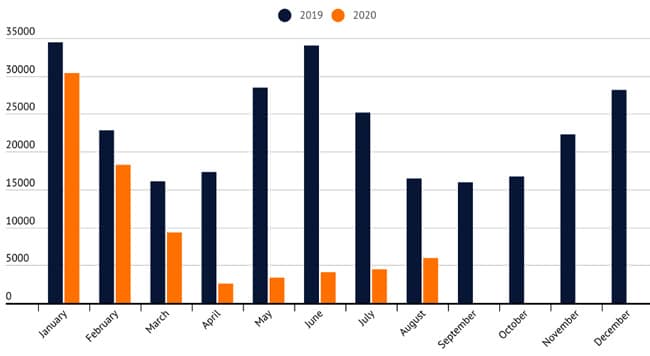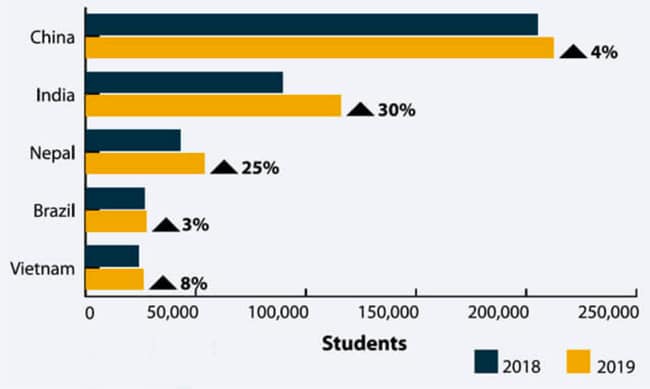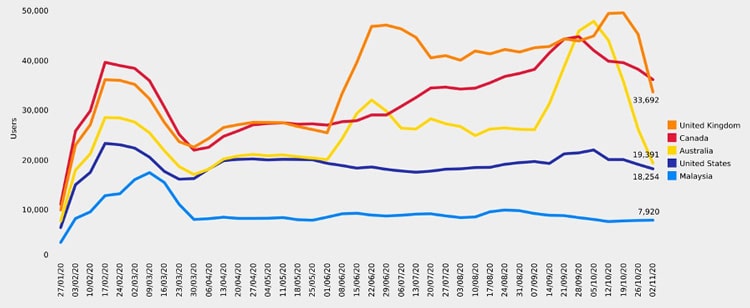Australia announces borders will stay closed as study projects international enrolment could fall by half by mid-2021
- A new report shows that international student numbers in Australia could fall by half by mid-2021 if borders remain closed
- Australian Prime Minister Scott Morrison has just announced that borders will remain closed to international students for the foreseeable future
- In 2019, more than 758,000 visa-holding international students were studying in Australia
- This year, there are about 210,000 fewer students due to COVID-19-related restrictions
- Department of Home Affairs data show an 80–90% decrease in study visa applications for Australia this year
Australia’s foreign enrolment is projected to drop to 50% of current numbers in 2021 if borders remain closed to international arrivals, according to a new report from the Mitchell Institute, an education think tank at Victoria University. The report, entitled Coronavirus and International Students, uses data to look at what’s happening to international enrolments in various Australian cities and to model what the next year will look like if the current border restrictions remain in place. The modelling shows that the international student population will drop to 300,000 by mid-2021 under current border policies.
In a related development, Prime Minister Scott Morrison announced today that the National Cabinet had determined that borders will remain closed to international students. The decision was made in order to prioritise the repatriation of Australians citizens stranded abroad due to limits this year on how many people could fly into Australia at one time. More Australians will now be allowed to travel back to Australia every day, with a goal of getting more than 25,000 of them back home.
Because thousands of Australians travelling back to the country will have to quarantine, the Prime Minister says that quarantine facilities would be stretched beyond capacity if international students were allowed to fly in as well:
"The challenges we have in getting Australians home means the ability to move and take international students back at this time through quarantine arrangements does not present itself.”
He told reporters in Canberra, “There is a queue, and Australians are in the front of the queue.”
The Prime Minister has given no indication as to when the policy will be reviewed or changed.
A strong base from 2019
Last year, there were 758,154 visa-holding students studying in Australia, representing growth of 9.7% over 2018 and reinforcing Australia’s position as the world’s second-leading study destination after only the United States.
But since March, there has been an 80–90% drop in overseas applications. Department of Home Affairs data show that at this point in the year, there are about 210,000 fewer international students in Australia than there would have been had the country not shut its borders on 20 March due to COVID-19.

The drastic fall in applications spells trouble for enrolment trends in 2021 because it represents a reduction in forward demand for Australian education when borders do reopen. Coronavirus and International Students report author Dr Peter Hurley says, “Australia is facing the dual problem of fewer international students [arriving] and currently enrolled students leaving the country.”
If the report’s modelling holds, Australia could lose more than AUS$20 billion as international students’ spending at their education institutions and in the wider economy also declines sharply.
Data from the Australian Bureau of Statistics show that international education contributed AUS$37.5 billion to the Australian economy in 2018/19.
Recovery forecast
The report emphasises that foreign enrolments will rebound eventually – and that the policies put in place now will help to determine how quickly that happens:
“Despite the severity of the current crisis, it seems not a case of if international students will return but when. It seems wise to add how to the discussions so Australia rebuilds with a more sustainable international student education model that delivers benefits for everyone, including international students.”
The Mitchell Institute’s city-by-city analysis shows that enrolment losses are playing out differently depending on the region and that the impact of closed borders is evolving. Mr Hurley says,
“The initial population shock most affected regions where Chinese international students lived, but future declines are likely to involve international students from all countries. This means the impact of falling international student enrolments will become more widespread.”
Last year, Australia’s top five sending countries accounted for nearly six in ten (57%) foreign students in the country’s education institutions.

Is Canada picking up share?
Speaking with The Age, Monash University vice-chancellor Margaret Gardner says that border closures are hurting Australian universities’ ability to attract students who would normally be choosing Australia for their studies right now:
“We have still got a high-quality education system, we have still got a country that is secure. It should be a country that is safe in every sense of the word. But none of those things make sense unless people can get here. There has to be political will and an agreement and those plans need to be made federally, because the states can’t open international borders.”
Melanie Macfarlane, a Sydney-based education consultant, says her office is seeing Australia beginning to lose students to Canada (where borders reopened to international students last month). She notes that loss of global market share would affect Australian enrolments for the next two to three years. Last year, Canada was the third-most popular destination globally (essentially tied with the UK) for international students, with 642,480 enrolled in 2019.
New data from IDP Connect show that online student searches for Australia and the UK have fallen significantly this quarter. Searches for Canada have also tapered off, but not as dramatically. In general, the chart below illustrates how volatile student searches have been this year as borders have closed and opened, as coronavirus infection rates have gone up and down in various countries, and as policies have changed in some destination countries vis a vis those in other destinations. Because of the pandemic, a trend line can go up or down far more quickly than it would in a typical year – which also underlines how much and how rapidly a new government policy can affect student demand.

As much as border closures are hurting Australia’s economy this year, the country is also developing a reputation around the world for how seriously its government is taking COVID-19 and how diligently it is trying to protect its citizens. The country’s record for safety and for beating back infection rates may not be helping international students to study in Australian institutions now, but it may well be a strong driver of Australia’s popularity when the pandemic is over.
For additional background, please see:
- “Australia approves pilot to bring international students to Northern Territory”
- “ICEF Exchange Podcast: Australia’s response to student safety, welfare, and support during COVID-19”
- “Country briefing: Australia rallies to provide additional supports for international students”
- “Australia’s foreign enrolment up 10% in 2019”


















